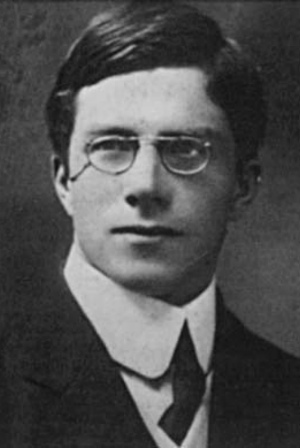Ronald Fisher facts for kids
Quick facts for kids
R.A. Fisher
|
|
|---|---|

Sir Ronald Aylmer Fisher (1890–1962)
|
|
| Born | 17 February 1890 |
| Died | 29 July 1962 (aged 72) |
| Nationality | |
| Alma mater | University of Cambridge |
| Known for | Natural selection Analysis of variance |
| Awards | Royal Medal (1938) Guy Medal in Gold (1946) Copley Medal (1955) |
| Scientific career | |
| Fields | Statistician Evolutionary biologist Geneticist |
| Institutions | Rothamsted Experimental Station University College London University of Cambridge CSIRO |
| Academic advisors | Sir James Jeans F.J.M. Stratton |
| Doctoral students | C.R. Rao; D. J. Finney |
| Influenced | W.D. Hamilton |
Sir Ronald Aylmer Fisher (born February 17, 1890 – died July 29, 1962) was an English scientist. He was a statistician, an evolutionary biologist, and a geneticist. People have called him a "genius" because he helped create the basic ideas for modern statistics. Another famous scientist, Richard Dawkins, said Fisher was "the greatest of Darwin's successors." This means he was very important in continuing Darwin's work on evolution.
Fisher's Important Work
In 1919, Fisher started working at Rothamsted Experimental Station in England. This place collected a lot of information about crops over many years. Fisher began studying this data, which led to many important discoveries.
Designing Experiments and Analyzing Data
Fisher was very productive during this time. He developed new ways to design experiments. This means he figured out the best ways to set up scientific tests so that the results would be clear and reliable. He also improved the analysis of variance, which is a statistical method to understand how different factors affect an outcome. He also studied statistics using small groups of data.
What was really important was how he used real-world data to create new statistical methods. He also thought about how much work it took to do these calculations and found practical ways to make them easier.
Fisher's Books for Scientists
In 1925, Fisher published his first book, Statistical Methods for Research Workers. This book became a standard guide for scientists in many different fields. It was printed many times and translated into different languages. Later, in 1935, he published The Design of Experiments, which also became a very important book.
Understanding Genetics and Evolution
Fisher was one of the three most important people in the field of population genetics, along with Sewall Wright and J.B.S. Haldane. Population genetics looks at how genes change in groups of living things over time. He helped start the idea of the modern evolutionary synthesis, which combines Darwin's ideas about natural selection with modern genetics.
He was also the first to use complex math (called diffusion equations) to figure out how often different genes appear in populations. He also found new ways to estimate how genes are linked together and how often they appear, using a method called maximum likelihood. In 1950, he used a computer for the first time in biology to study how gene frequencies change across different areas.
Natural Selection and Polymorphism
Fisher worked closely with E. B. Ford on a field called ecological genetics. Their work showed that natural selection (the process where living things that are better suited to their environment tend to survive and have more offspring) is often much stronger than people had thought. They found that many situations in nature, like polymorphism (when a species has two or more clear forms, like different colors of butterflies), were not just random. Instead, they were kept stable by the strong force of natural selection.
Fisher also came up with the idea of heterozygote advantage. This happens when having two different versions of a gene (one from each parent) is better than having two identical versions. This idea was later found to be very common in genetic polymorphism. Finding clear examples of natural selection happening in nature was a big part of the modern understanding of evolution.
Fisher's Ideas on Genetics and Society
Fisher was interested in how genetics could be used to improve human populations. This field is called eugenics. From 1933 to 1943, he held a special position at University College London focusing on eugenics. Later, he became a Professor of Genetics at Cambridge University.
In 1934, Fisher tried to give scientists more power within the Eugenics Society. However, some members disagreed, believing that environment was more important than genetics. Because of this disagreement, Fisher and many other scientists left the society.
Fisher's Important Books
Fisher wrote three very important books that changed how scientists thought about statistics and genetics.
The Genetical Theory of Natural Selection
Fisher started writing The Genetical Theory of Natural Selection in 1928, and it was published in 1930. A second edition came out in 1950. In this book, he explored ideas about sexual selection (how traits evolve because they help in finding a mate), mimicry (when one species looks like another), and how dominance (when one gene version hides the effect of another) evolves.
He showed that if a mutation (a change in DNA) makes an organism much fitter, it's less likely to happen. He also proved that larger groups of living things have more genetic differences and a better chance of surviving. This book laid the groundwork for what we now call population genetics.
A part of the book looked at how these ideas applied to humans. Fisher believed that families with many children should receive financial support. He himself had eight children (two sons and six daughters). His large family showed his strong beliefs about genetics and evolution. This book also greatly influenced another scientist, W.D. Hamilton, and his ideas about how genes affect kin selection (when an animal helps its relatives, even if it harms itself).
Statistical Methods for Research Workers
Statistical Methods for Research Workers (published in 1925) is a classic book about statistics. It is one of the most important books on statistical methods from the 20th century. This book helped many scientists learn and use statistical methods in their own research.
Design of Experiments
Fisher's book Design of Experiments (published in 1935) was also very important. It helped scientists understand how to plan their experiments well. The book focused on the practical use of statistical techniques.
Images for kids
See also
 In Spanish: Ronald Fisher para niños
In Spanish: Ronald Fisher para niños








